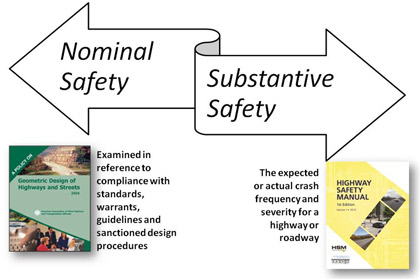U.S. Department of Transportation
Federal Highway Administration
1200 New Jersey Avenue, SE
Washington, DC 20590
202-366-4000
The AASHTO Highway Safety Manual (HSM), published in 2010, represents the culmination of 10 years of research and development by an international team of safety experts, academics, and practitioners. The HSM was envisioned as a companion document to and modeled after the well-known Highway Capacity Manual. Under leadership from both the American Association of State Highway Officials (AASHTO) through the National Cooperative Highway Research Program (NCHRP) and the Federal Highway Administration (FHWA), and with direction from a Task Force of the Transportation Research Board (TRB), a major research program provided the technical contents of the HSM and also funded its development into a practitioner-friendly document.
The HSM represents the greatest potential for influencing the actions and outcomes of state DOTs in the past 50 years. The HSM captures the knowledge base associated with the proven relationship between crashes and their outcomes and actions or implemented decisions. The HSM is intended for use by any and all professionals charged with planning, design, construction, operations, and maintenance of a road or highway system. The HSM was developed through funding from AASHTO and the FHWA. The research basis for HSM contents has its foundation in National Academies administered peer-reviewed research. As such, users of the document can apply the values and methods with confidence, knowing they represent the best science available at the time of its publication.
This document is intended as a reference for managers of state DOTs and local highway agencies that are interested in or responsible for initiating the implementation of the AASHTO HSM within their organization. It provides guidance on processes, resources, approaches, and lessons learned from early adopters of the HSM.
The guide offers background on what the HSM is and what its benefits to users will be. It presents considerations to managers assigned the task of participating in or leading an HSM implementation effort. These considerations come from discussion with DOT peers who have already begun implementation and have learned valuable lessons.
Management strategies are suggested, including the need for a champion, key executive leadership support, and development of a specially tailored implementation plan, which would include training, organizational issues, revisions to agency policies and procedures, risk management, data availability, analytical tools, and information technology.
The second major section of the guide covers how the HSM, once implemented and institutionalized, can affect program and project delivery for all projects – not just those concerned with safety improvements.
For further assistance or background on the HSM, users of this Guide are encouraged to visit HSM web site.
Safety is a core value of most if not all state DOTs. Safety plays a prominent role in the mission or vision statements of most. Customers, highway system users, and taxpayers have been assured and told that maintaining or improving safety is a top priority, and that much of an agency’s investments are intended to produce a “safe” highway or system.
“Safety” has traditionally been incorporated in highway programs and projects within a “standards-based” framework. Design standards, design policies, and warrants such as the AASHTO Policy on Geometric Design, AASHTO Roadside Design Guide, and Manual on Uniform Traffic Control Devices, and individual state DOT design manuals are the core basis for decision-making and project development. Many agencies have sophisticated asset management systems that facilitate system monitoring and program development of hard assets such as bridges and pavement, but lack comparable systems for safety.
Standards, manuals, warrants, etc., serve many purposes. Among them are quality control, efficiency in design, and consistency in approach that translates to better understanding of contractors and better bids. Many design standards have some element of safety assumed or implied by their derivation of design values, but in many cases there are other considerations besides safety in how and why a design standard or design values were established. Indeed, a deep understanding of the background behind much of industry practice shows that such presumptive relationships in fact often do not exist. Ezra Hauer, a noted researcher in highway safety, referred in 1999 to the use of standards in the context of delivering safety as nominal safety.
What is different about the HSM, and where it offers potentially significant benefits to agencies, is in the introduction of a second dimension of safety, which Hauer described as substantive safety. Exhibit 1 demonstrates the difference between nominal and substantive safety. Substantive safety is quite simply the performance of a facility as measured by crashes and their outcomes, fatalities and injury. In the context of DOT programs and actions, the known substantive safety, when compared to a statistically reliable and relevant threshold, provides a basis for decision-making around project selection, scope, and basic approach. For contemplated actions or alternatives, the predicted or expected substantive safety of each alternative can be assessed and thus contribute to the selection of a preferred approach.
EXHIBIT 1. Nominal and Substantive Safety Concepts

By providing a way of estimating or understanding the substantive safety implications of design decisions or actions, DOTs can now:
In effect, the full implementation and use of the HSM will help a DOT accomplish what its customers and stakeholders expect, which is providing the highest level of safety performance for the financial and other resources provided to the DOT. Managers should understand and communicate to staff that the full acceptance and implementation of the approaches, methods, and values in the HSM and companion resources offers substantial systematic benefits for enhancing safety.
